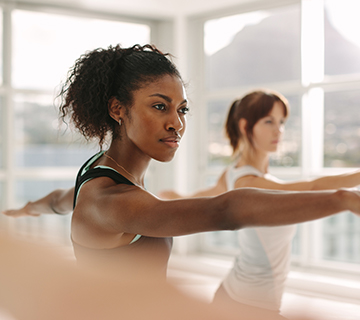How to Avoid a Fitness Plateau

Remember when you first started your workout routine? Back when you were physically challenged by every exercise. Now, add weeks of repetition to the mix. After a while, don’t you feel like your routine has become a little too easy?
Even though this may be a sign of good progress, it can also mean your fitness level is plateauing due to muscle memory. You’re probably sick of hearing of the whole “no pain, no gain” speech, but it’s somewhat based on logic. Your body’s nervous system, muscles and other physiological systems adapt to your workout, making further progress difficult when sticking to the same routine. So, what’s the key to avoiding this? Variety. Here are some ways you can mix up your workouts in the four main exercise categories.
Check with your healthcare provider before starting a new exercise program.
Endurance
Let’s face it, cardio is not always fun. But it’s extremely important for keeping your heart healthy, and it will make you better at other exercises in the long run—no pun intended. There are so many types of aerobic exercises to choose from, so try switching things up from time to time. If you can’t quit your favorite cardio, mix a little bit of another type into your routine. The options are endless: walking, running, biking, swimming, climbing, jumping, dancing, the list goes on.
Connect your wearable activity tracker or favorite mobile fitness app to your Health Tools account and sync your exercise goals in one centralized, secure place. Once set up, your associated data will be automatically updated in the Online Health Coach.
Strength
Building muscle requires a little more variety. You need to introduce stimuli that are progressively more challenging into your workouts, otherwise your muscles will adapt to them. Going up in weight isn’t the only option, though. Try jumping from one exercise method to another, weekly. For example, you could go from weights, to resistance bands, to body weight exercises, to machines. For added variety, jump from high rep, low weight routines to high weight, low rep routines every other month.
Balance
Balance gets more important with age. As you get older, poor balance increases your chances of injury or falling. All variations of yoga are great for balance. If you’re not big into yoga already, try to go to a class once every two weeks. It’s a great way to break from your other exercise routines.
Flexibility
It may be tedious, but you should always stretch after your workouts. Flexibility helps you move your muscles and joints through a full range of motion, promoting a healthy, limber body. Again, yoga will help with flexibility, but there are tons of stretches you can do on your own as well. For a list of basic stretches, check out this article.
Article source link has expired.


